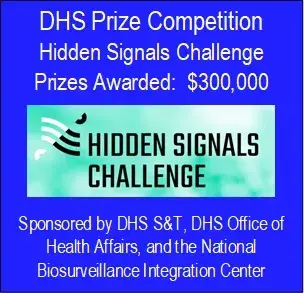 Challenge Overview: DHS S&T, DHS Office of Health Affairs (OHA), and the OHA National Biosurveillance Integration Center, called upon data innovators from a wide variety of fields—from data science, to civic tech, to epidemiology—to develop concepts for novel uses of existing data that will identify signals and achieve timelier alerts for biothreats in our cities and communities. This is intended to be the first step in the design of a local and/or national-level system that could enable city-level operators to make critical and proactive decisions based on the most relevant and actionable insights. The challenge focused on large metropolitan areas such as New York, Los Angeles, Chicago, Boston, Atlanta, and Washington, D.C., as the basis for a proof of concept.
Challenge Overview: DHS S&T, DHS Office of Health Affairs (OHA), and the OHA National Biosurveillance Integration Center, called upon data innovators from a wide variety of fields—from data science, to civic tech, to epidemiology—to develop concepts for novel uses of existing data that will identify signals and achieve timelier alerts for biothreats in our cities and communities. This is intended to be the first step in the design of a local and/or national-level system that could enable city-level operators to make critical and proactive decisions based on the most relevant and actionable insights. The challenge focused on large metropolitan areas such as New York, Los Angeles, Chicago, Boston, Atlanta, and Washington, D.C., as the basis for a proof of concept.
Results Phase I
Five finalists were selected by the judges according to official challenge criteria, and each awarded $20,000 in cash prizes.
Finalists from Phase I had the opportunity to further develop concepts into detailed system designs with guidance from expert mentors. At the end of Phase II, finalists were required to submit their detailed system designs, which describe how the concepts from Phase I are to be implemented in practice. The five Phase I finalists are:
- Readiness Acceleration & Innovation Network (RAIN), Tacoma, WA for Commuter Pattern Analysis for Early Biothreat Detection, a system that cross-references de-identified traffic information with existing municipal health data and Internet keyword searches. The tool will be developed to recognize commuter absenteeism to flag a possible disease outbreak.
- Vituity, Emeryville, CA for monitoring emergency department wait times to detect emergent influenza pandemics, a model that alerts authorities of spikes in emergency room wait times that can be attributed to emergent flu pandemics. The solution sources real-time data from a network of 142 hospitals in 19 states and is updated hourly, allowing agencies to quickly intervene.
- William Pilkington & team, Cabarrus County, North Carolina, for One Health Alert System, a symptoms database that analyzes the Daily Disease Report’s top ten symptoms as seen by 43 health care providers in North Carolina. The model flags disease outbreaks using textual predictive analytics and accounts for seasonal rates of change.
- Computational Epidemiology Lab at Boston Children's Hospital, Boston, MA for Pandemic Pulse, a tool that integrates six data streams to detect bio-threat signals. First, it alerts agencies using Twitter, Google Search, transportation, news, and HealthMap data of an anomaly in the data stream, then it tracks potential biothreats using live transportation data on Flu Near You.
- Daniel B. Neill and Mallory Nobles, Pittsburgh, PA, for Pre-syndromic Surveillance, a machine learning system that overlays real-time emergency room chief complaint data with social media and news data using the semantic scan, a novel approach to text analysis. The model detects emerging clusters of rare disease cases that do not correspond to known syndrome types.
Results Phase II
Finalists from Phase I further developed their concepts into detailed system designs, with guidance from expert mentors as they competed for an additional $200,000 in cash prizes. At the end of Phase II, finalists submitted detailed system designs describing how concepts from Phase I will be implemented in practice.
1st Place Winner: The Computational Epidemiology Lab at Boston Children’s Hospital will receive the grand prize of $150,000 for their proposed solution called Pandemic Pulse. This system provides a dashboard that integrates Twitter and Google Search data with infectious disease monitoring tools, Flu Near You and HealthMap, to detect biothreat signals. The tool filters data based on pathogen category, information source, and transmission mode, using a tiered evaluation method.
2nd Place Winner: The runner-up solution, Pre-syndromic Surveillance, submitted by Daniel B. Neill and Mallory Nobles of Pittsburgh, Pennsylvania, will receive $50,000. This system integrates emergency department chief complaints with data from health clinics and social media to discover outbreaks that do not correspond with known illnesses. The team is piloting a working prototype with New York City's Department of Health and Mental Hygiene and other city agencies.
